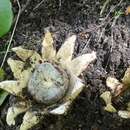en
names in breadcrumbs


Geastrum (orthographical variant Geaster)[1] is a genus of puffball-like mushrooms in the family Geastraceae. Many species are known commonly as earthstars.
The name, which comes from geo meaning earth and aster meaning star, refers to the behavior of the outer peridium. At maturity, the outer layer of the fruiting body splits into segments which turn outward creating a star-like pattern on the ground. The inner peridium is called a spore sac. In some species, the outer peridium splits from a middle layer, causing the spore sac to arch off the ground. If the outer peridium opens when wet and closes when dry, it is described as hygroscopic.
In some species, the inner peridium is borne on a stalk or pedicel. The columella is a column-like clump of sterile tissue found inside the inner peridium. The network of fertile tissue inside the inner peridium, the capillitium, arises from the columella And is where basidia and basidiospores are produced. The mouth in most species of "earth-stars" is quite prominent, often arising as a small cone at the apex of the inner peridium. It may be even or sulcate (grooved).[2]
They are generally not toxic but considered non-edible due to their fibrous texture in the mature stage at which they are generally found.
Although the Dictionary of the Fungi (2008) estimated roughly 50 species in Geastrum,[3] a more recent estimate (2014) suggests that there may be up to 120 species.[4] Geastrum coronatum Pers. has been proposed as the conserved type for the genus.[5] Some similar species that are otherwise difficult to differentiate using classical morphological features (such as G. triplex, G. saccatum, and G. lageniforme) can be identified using chemical spot tests that detect phenoloxidase enzymatic activity, a differences in the crystal structure of calcium oxalate deposits[6] or DNA sequences. Species include:
Geastrum (orthographical variant Geaster) is a genus of puffball-like mushrooms in the family Geastraceae. Many species are known commonly as earthstars.
The name, which comes from geo meaning earth and aster meaning star, refers to the behavior of the outer peridium. At maturity, the outer layer of the fruiting body splits into segments which turn outward creating a star-like pattern on the ground. The inner peridium is called a spore sac. In some species, the outer peridium splits from a middle layer, causing the spore sac to arch off the ground. If the outer peridium opens when wet and closes when dry, it is described as hygroscopic.
In some species, the inner peridium is borne on a stalk or pedicel. The columella is a column-like clump of sterile tissue found inside the inner peridium. The network of fertile tissue inside the inner peridium, the capillitium, arises from the columella And is where basidia and basidiospores are produced. The mouth in most species of "earth-stars" is quite prominent, often arising as a small cone at the apex of the inner peridium. It may be even or sulcate (grooved).
They are generally not toxic but considered non-edible due to their fibrous texture in the mature stage at which they are generally found.